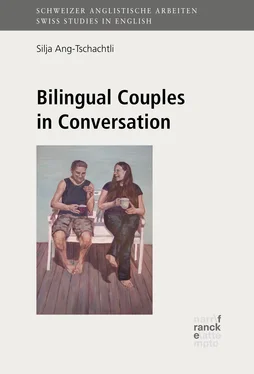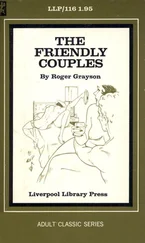After the description of the setting, subjects and methodology for data collection, I present the main body of my analysis, which has been divided into six chapters. I begin in chapter 5with what may be the most influential factor in determining the manner in which the couples communicate, namely their language choice. After outlining the factors that have been found to influence language choice in bilinguals, I discuss the couples’ reported language use with each other, and the reasons behind this. In addition, their language use outside the home is discussed, as this may be connected to their language proficiency, attitudes, and/or level of integration. In the same chapter, I also document some aspects that the couples report as unusual about their way of communicating. This includes topics such as moderating their manner of speaking, and the high level of communication and mutual understanding that they claim to have achieved as a result of their different backgrounds.
Chapter 6examines the couples’ language mixing behaviour. This chapter is a combination of the couples’ reports on their language mixing on the one hand, and their mixing behaviour during the interviews on the other. In order to analyse their language mixing, I distinguish between code-switches and borrowings, between hedged and unhedged switches, and between spontaneous and metalinguistic switches. The participants’ language switching behaviour is then analysed with reference to a number of variables, such as their family situation, mother tongue and gender, and compared to their reports about their mixing behaviour and their views on language mixing.
After this, I turn to more specific areas in the couples’ communication and relationships. In chapter 7, I look more closely at the topics of attitudeattitudes and attraction, as these influence the couples’ linguistic behaviour considerably. I discuss parallels in what the participants found attractive about each other initially, as well as the development of their attitudes towards their partners’ language and culture over the course of their relationship. Moreover, I examine their views on being a bilingual, bicultural couple, and discuss the expectations, hopes and worries the couples voice with regard to raising bilingual childrenbilingualchildren. As the topic of raising bilingual children has been widely researched and documented, this aspect is discussed only briefly; nevertheless, it is included in the interests of comprehensiveness. Furthermore, children may also have an influence on the language use of a bilingual couple, and the partners’ private language planning gives us clues about covert attitudes.
The topic of expressing emotions in a bilingual relationship is addressed in chapter 8.In this chapter, I examine which terms the couples use to express positive and negative emotions during the interviews, as well as the voice quality and terminal pitch accompanying the expression of emotions. I also analyse to what extent speakers with different genders or mother tongues differ in their expression of emotion. The couples’ thoughts on expressing positive and negative emotions in a second language are also discussed, as are potential issues for their relationship that arise from their situation, and strategies for dealing with these issues.
In chapter 9, the bilinguals’ use of swearwords is analysed. I discuss both their reported use of swearwords and their swearing behaviour during the interviews, with particular focus on their language choice, as well as the role of gender, mother tongue, nationality and family situation. Furthermore, I explore the interviewees’ reactions to their partners’ use of swearwords, and the taboos associated with swearwords in their first and second language.
Finally, I look at the role and function of humour and laughter in the couples’ conversations ( chapter 10).I first analyse the manner in which the couples use humour during the interviews, with particular attention to the topics that trigger laughter, as well as who laughs about whom, and with what frequency. I also discuss the participants’ use of a laughing and smiling voice quality during the interviews, and see if any aspects of their laughing behaviour seem to be influenced by the factors of gender or mother tongue. In the second part of the chapter, I offer an overview of the bilinguals’ reports on their individual and couple humour. In addition, challenges that are brought about by cultural and linguistic differences in humour are examined, as well as shared couple humour. In this context, I also explore an aspect that many of the couples report as typical of the manner in which they communicate, namely the use of playful language, for instance by inventing words or imitating accents, as all of this is usually done in a humorous key. In the final chapter ( chapter 11), I then provide a short overview of the most important findings of my analysis, and discuss the implications of these results for future research.
2 Language situation in Switzerland
2.1 Introduction
This chapter focuses on the language situation in Switzerland with regard to the country’s multilingualism as well as the diglossic situation in the German-speaking part. Both of these aspects are potentially relevant for the couples’ attitudes towards their two languages and may therefore influence their language choice and use. Moreover, the role and status of English in Switzerland is examined, as well as the linguistic and ideological challengeschallengeslinguistic Anglophone immigrants may face there. With regard to all of these topics, the chapter concentrates on the German-speaking regions of Switzerland, because the interviewees live in this area.
2.2 Multilingualismmultilingualism in Switzerland
In 2016, Switzerland had a population of about 8.4 million people, 24.9% of whom were foreign nationals (BFS 2017).2 Switzerland is officially a quadrilingual country, with four national languages: German, French, Italian and Romansh. However, Swiss nationals are seldom fluent in all (or even two) of these languages, and many people do not grow up in a bilingual environmentenvironmentlinguistic. Rather, each of the four national languages is spoken within a specific territory which is effectively monolingual (with the exception of a few bilingual areas). In the 2014 survey on the population’s main language(s), 63.3% of the population indicated (Swiss) German, 22.7% French, 8.1% Italian, and 0.5% Romansh as their main language. A total of 22.3% of the population named a non-local language as their main language (or one of their main languages); English was spoken as a main language by 4.6% of the population (BFS 2016a).3 While not all inhabitants use other languages regularly, at least two foreign languages4 are usually learnt at school. Moreover, 38.7% of the adult population indicated in the 2014 census that they regularly use more than one language privately and/or professionally (BFS 2016a).
Even though the majority of the Swiss population may be confined to mainly using one language in their daily lives, it has been noted that being a multilingual country is part of the Swiss national self-image and cultural identityidentitycultural (Stevenson 1997: 22; Murray 2003a: 103). Consequently, it is often argued — especially in political debates — that “the Swiss should be multilingual and able to communicate with each other in their national languages as a way to better mutual understanding” (Murray 2003a: 103). As Rash points out, the acquisition of a second national language is often “seen as central to intercommunal harmony” (2003: 123). At the same time, many Swiss recognize the importance of speaking English well in an international context, which is why second language teachinglanguage teaching is a hotly debated topic. There is disagreement concerning which foreign language should be learnt first in each canton — a national language or English — and at what age these foreign languages should be acquired. In 2004, it was decided that all Swiss students should start learning a second language in third grade, and a third language in fifth grade. One of these languages has to be a national language, but apart from that it is up to each canton to decide which foreign languages their students will learn, and in what order. This new curriculum, the Lehrplan 21 Lehrplan 21, has been introduced at schools in most cantons (Lehrplan 21, 2017). As a result, English is currently the first foreign language taught in 16 of the German-speaking cantons. However, some German-speaking cantons do not follow the rule that a third language has to be introduced by the fifth grade, and do not start teaching it until the ninth grade. This recently led federal council member Alain Berset to impose an ultimatum on all cantons, which was front-page news in many Swiss newspapers (e.g. Häfliger and Burri 2016). On the other hand, a popular initiative in the canton of Zurich which aimed to postpone learning one foreign language until secondary school (seventh grade) was rejected by the majority of the voters (60.8%) in May 2017. The fact that there are frequent headlines and political discussions on the topic of second language teaching in schools shows both the controversial nature of the topic and the importance attributed to language learning in Switzerland (see also section 2.4, “English in Switzerland”).
Читать дальше












